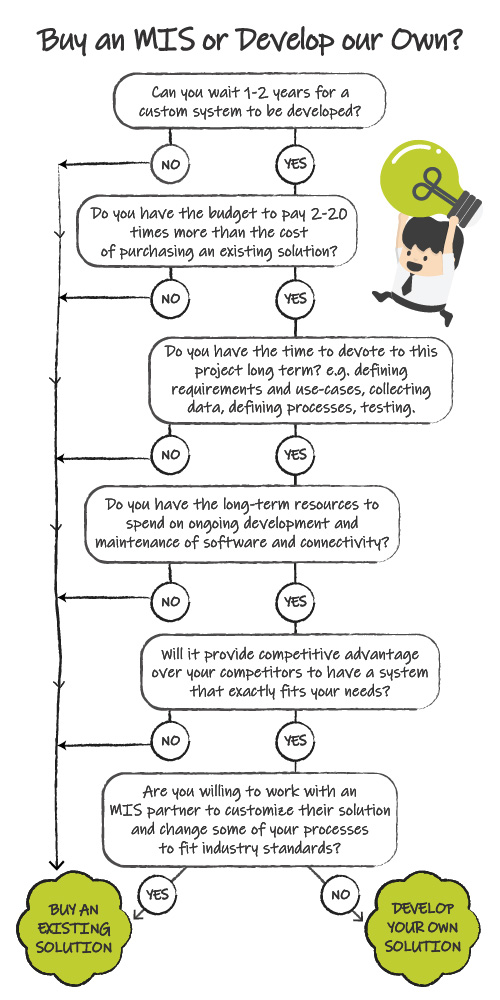I’m sure you’re probably thinking that this article is only going to go one way, so we'd like to briefly address this before we start….
Are we only going to recommend buying an existing solution? No, not necessarily, and here’s why…
Firstly, we always want to make sure that our solution is the right fit for any customers we work with - the right fit for their requirements and aspirations and culture. And if we recognize it’s not right, we’re not afraid to say so.
Secondly, we’re big believers in the value of software development. It’s what’s made our products what they are today. We recognize the power and value of having resource at hand to enable you to shape a product the way you want it. It’s also why we would always encourage a company with particularly specific needs to consider embarking on their own custom development solution.
Thirdly, we’re absolutely happy to work with new and existing customers on customization projects to make our MIS and their systems work for their particular workflow. However, these projects do tie up our development team from working on the innovative stuff on our roadmap (the stuff we get really excited about), which is one of the reasons why we’re big advocates of our customers who want to get even more out of their MIS, having their own in-house development resource.
Whatever approach you choose, your system should be the backbone of your workflow but at the same time allow you to tie together all your other systems and departments. It’s how you get there that’s the real question.
Now that’s addressed, which path should you take?
The quick answer is this – it depends on your company, needs, budget, resources and timeframes. Here are the things you’ll need to consider to help you decide which path is the right one for you...
1. Cost
Image created by rawpixel.com - www.freepik.com
- In most cases, buying an existing solution will be cheaper than creating your own. Software development company Atomic suggest “that difference can cost from twice to 20 times more.” It goes without saying that an MIS company can amortize the cost of developing and maintaining an MIS solution over perhaps hundreds of printing companies, but a printing company will bear the full brunt of the development cost of a custom project. To get a rough idea of cost for a custom project, Atomic suggest you take the cost of an off the shelf package and multiply by 10. A typical 5 user Tharstern Desktop solution can range from a starting investment of £15,000 - £20,000. You can take it from here and do the math…
- It’s important to point out that technological changes are accelerating at an almost exponential rate, and any software created internally will need to be maintained and upgraded to keep up. This is especially relevant if you intend to connect your solution to other software applications (as most MIS solutions do), because every time those other applications have an update, not only will you have to test it still works but you’ll more than likely have to update your custom solution too. Sometimes this is a quick job and other times it requires a fundamental re-write of the connection.
We recently had to do this at Tharstern when Sage decided to remove compatibility to certain tools and technologies in V24 of Sage50, a product many of our customers use for their accounting. This resulted in many months of architectural re-writing of our integration link, something that caused frustration for some customers and additional development costs for ourselves. As a software company, we obviously plan for ‘surprise’ incidents like this and so can deal with them, but could you do the same?
2. Time
Image created by rawpixel.com - www.freepik.com
- Which option is going to get you where you need to be the quickest? Do you need a new solution by a certain timeframe? Existing systems are available immediately, whereas developing a custom MIS could take years (dependent on how much budget you can throw at it, of course).
- You will obviously have to devote a substantial amount of time and effort to a custom development project for at least 1-2 years (again, dependent on how much budget you have), even if you are using a third-party company to develop the solution. You will need to define requirements and use-cases, collect data and define processes. You’ll probably also need to explain and educate them about printing processes, ink colors and industry standards, along with details of how your particular workflow runs.
- You should also consider whether you have the time available for ongoing maintenance too - we’re currently speaking to several print businesses who successfully developed their own system but are now finding that maintaining the system is taking up too much time. For one in particular it’s distracting their in-house developers to the point that it’s stopping them from providing the chargeable services they offer to their own clients.
- A study conducted by McKinsey found that a third of enterprise software projects go beyond the estimated schedule, 66% have cost overruns and almost 20% of them fall short of promised benefits. So if you’re going to get a software development company to create a custom system, think about what incentives / penalties you can put in place to keep control of timescales and costs.
3. Control
Image created by rawpixel.com - www.freepik.com
- If having control over every aspect of your MIS design, interface and functionality is really important to you, then you should definitely consider a custom development. The same applies if you’re looking for a system to be a 100% perfect match to your specifications. An existing print industry specific MIS will have been developed to meet MOST of the needs of MOST printing businesses, and each customer will need to adapt their processes and workflow to fit in with the way that software works.
While this needn’t be a bad thing (after all, the software will have been written with industry best practice in mind) some companies absolutely cannot, or don’t want to, change the way they work, for varying reasons. It all hinges on the LEVEL of control that you need. If you’re happy with a 70-90% fit in a reasonably short period of time and are happy to make changes to your processes too, then a custom project isn’t necessary. An ‘off-the-shelf’ solution is worth considering. However, if you just can’t change some processes or need a better fit, a good solution provider should be willing to listen to where you feel the gaps are.
If addressing your challenges are seen as a benefit to other customers, then most likely they will address them as part of your solution implementation. If the requirements are very specific to your business though, they would normally be happy to provide chargeable services to customize their solution to your business / workflow. Alternatively, you could use your own development resources to address the gaps yourself and build around the MIS. - Often taking a ready-made system and developing around it can give you the best of both worlds, being more cost effective and much quicker than having to start from scratch. It’s that adage ‘why try to re-invent the wheel’. In this scenario it then becomes more a question of who is best to do this for you. Your supplier, a 3rd part developer or your own internal resource. But if you want/need FULL control of your MIS solution and can’t/don’t want to change how your business operates in any way, a custom solution is definitely the way to go!
- If you’re going to get a software development company to create a custom system for you make sure you check who will own and have control of the Intellectual Property rights for the final application.
4. Risk
Image created by rawpixel.com - www.freepik.com
- How risk averse are you? Custom development projects are costly and take a lot of time. They’re also easy to get wrong if you don’t know what you’re doing. There are plenty of horror stories on the web about failed development projects; take a look at this scary selection - the 9 year £20bn failed project for the NHS is particularly stomach churning. We’d recommend thinking about using a development manager experienced in software projects who can then set up the methodology, policies, processes and procedures and then take on board the hiring of the rest of the team.
- Some key advice here would be to make sure the project isn’t reliant on one person’s knowledge or expertise as this often presents a risk to businesses further down the line should that employee choose to leave during or after the initial development phase. We’re currently talking to a few companies who are experiencing something similar with a third-party or in-house developer they have worked with for many years, who is now retiring without any plans for succession. In our experience, this is the number one problem businesses with a custom solution face and why they approach us.
If you look to reputable MIS houses and large development providers they will offer ESCROW agreements (a way to guarantee access to the source code) and typically have a sizable development team and have technical authors to document the design / functionality. - If you’re going to use an internal developer / external software development or MIS provider, how reliable, viable and stable are they? Have they got the right skill set? What track record have they got for delivering custom software solutions or MIS solutions to businesses similar to yours? Are they big enough to support you now and going to be around in the future too?
5. Future proofing 
Image created by rawpixel.com - www.freepik.com
- If you want to diversify into a different type of print production or value added services later on, your custom solution will need to be redeveloped to accommodate this. In software development what often seems like an easy or simple idea to me and you, is usually way more complex. So don’t be fooled into thinking something like this will always be a small job – it could actually mean a costly and time consuming re-write of many of the algorithms and functionality of your entire solution – from estimating through to production and everything in between. In our experience, this is second biggest problem businesses face and why they approach us to help them.
Developing a custom solution is clearly not for the faint hearted, but it is the right thing for some companies.

Image created by rawpixel.com - www.freepik.com
There are certainly some compelling reasons not to head down the custom development path, particularly if time and money are the most important factors to your business right now. If this is the case for you, we definitely recommend you harness an existing MIS solution.
But if these aren’t important factors for you, and you’re still considering the custom route, then ask yourself these final 3 questions:
1. Will a custom solution provide a competitive lead over your competitors?
If you answer ‘no’ to this question, then you really shouldn’t be considering a custom solution. Developing your own MIS solution poses many challenges and risks and requires a lot of resource, so if it isn’t going to give you an edge over the competition, what is the advantage?
2. How different is our business to my competitors?
What you’re trying to understand here is - are you really so different from your respected industry peers (who most likely use an MIS) that this warrants developing a customized system? Maybe look at businesses you aspire to be like and ask yourself:
- Are your processes likely to be similar or the same?
- Are your methods of manufacture similar or vastly different?
- Do you serve similar or the same customers?
- What systems do your competitors use?
If you still feel you’re alone here and not really got much in common with other businesses in your sector, or find that actually most your peers use custom developed systems, then it’s looking likely you need to investigate a custom solution too. But if on the other hand you feel that actually, you’ve got a lot of things in common with your industry peers, then consider this final question...
3. Are you able and happy to work with an MIS provider to make their solution work for you, by:- Changing some of your business processes to fit in with industry standards, and:
- Perhaps embarking on a smaller development project to customize an existing MIS solution?
If you answered ‘no’ to this question, then you should absolutely consider going down the custom development route. Why not take a look at this webinar we delivered, about working with third party development agencies, and hiring your own in-house development resource too.
Hybrid solutions
On the other hand, if you answered yes to question 3 above, then you could save yourself a lot of time, money and opportunity costs by working with an MIS provider to harness their off-the-shelf solution and customize it for your company.
Solutions that have an open database, integration capabilities and an API will provide you with the most opportunities for customization. Having your own in-house developer will open up these opportunities even more. You will be able to use your supplier’s software as your core system and then develop around it. Which will help you get to where you want to be quicker and cheaper while still giving you the unique functionality and tools that made you consider a custom project in the first place.
You can use our decision making flowchart to help guide your decision as to whether you should develop your own MIS or buy one!

Share this
You May Also Like
These Related Stories

The cost of doing nothing: Why you can’t afford to sit on a software decision

MIS Solutions: A Brief History of Print MIS
